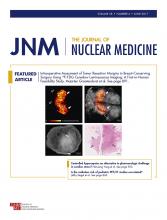TO THE EDITOR: The lead article, by Siegel et al. (1), in the January 2017 issue of The Journal of Nuclear Medicine is brilliant, timely, and scientifically superb. Unfortunately, the Invited Perspective by Weber and Zanzonico (2) that follows it is scientifically poor and inconsistent. The authors strive to hang on to the long-outdated ideas espoused by government bureaucrats by implying that we just do not know the truth yet, and they ignore a huge mass of valid scientific literature in doing so.
Calling the linear no-threshold (LNT) model controversial is the first problem. A solid body of science is against it, and those who treat it as a religion—or whose jobs, contracts, grants, or consulting positions depend on acceptance of the LNT model—are in favor of it. That does not make it controversial. Weber and Zanzonico quote a few studies to support the LNT model that have been discredited because of biased statistics, insufficient data, wrong data, and faulty experimental design. They ignore a large body of credible data covered in part in the paper by Siegel et al.
Weber and Zanzonico admit that there is radiation repair. Absence of radiation repair is an essential assumption of the LNT. Right there they are inconsistent. One cannot admit to radiation repair and still be an LNT advocate without being scientifically inconsistent.
Weber and Zanzonico claim, “No prospective epidemiologic studies with appropriate nonirradiated controls have definitively demonstrated either the adverse effects or the hormetic effects of radiation doses under 100 mSv (10 rem) in humans, and current estimates of the risks of low-dose radiation indicate that very large-scale epidemiologic studies with long-term follow-up would be needed to actually quantify any such risk or benefit; such studies may be logistically and financially prohibitive.” I disagree and mention two examples. In Canadian sanatoriums from 1930 to 1952, 31,710 female patients with tuberculosis were subjected to multiple fluoroscopies to monitor their disease status (3,4). Of these patients, 26.4% received radiation doses of 10 cGy (10 rads) or more to the affected side, and therefore most received lower doses. The relative risk of eventual breast cancer was studied in all these patients. Patients who received a total absorbed radiation dose in the range of 5–30 cGy (5–30 rads) had a breast cancer incidence up to one third less than the baseline incidence. Only at absorbed radiation doses above 50 cGy (50 rads) did the cancer incidence begin to increase above baseline. In these patients, the unirradiated breast was the control.
After World War II, patients with hyperthyroidism began to be treated with 131I-NaI instead of surgery. There was concern about late effects from the radiation. The Cooperative Thyrotoxicosis Therapy Follow-Up Study of over 36,000 treated hyperthyroid patients looked at eventual leukemia rates in these patients, as leukemia is considered among the most radiosensitive of cancers and occurs faster than other radiogenic cancers. The total-body radiation doses to the patients treated with 131I were 130–140 mSv (13–14 rem). The age-adjusted leukemia incidence rate was 11/100,000 patient-years in patients treated with 131I and 14/100,000 patient-years in patients treated with surgical removal of the thyroid gland. Although the authors concluded that there was no increased incidence of leukemia at this low whole-body radiation dose (5), the 22% decrease in the 131I-treated patients suggests a possible hormetic effect. The surgery-treated patients were the controls, the number of patients followed was large, and all had hyperthyroidism.
The poor scientific quality of the Weber and Zanzonico commentary is perhaps the most important feature of their contribution. If this is the best the agnostics can do, it is certainly a plus for finally removing the LNT model from radiation protection “science.” The earth is not flat, there is no ether, disease is not caused by miasmas, and the LNT model is wrong because of our knowledge of repair and carcinogenesis mechanisms.
Footnotes
Published online Feb. 16, 2017.
- © 2017 by the Society of Nuclear Medicine and Molecular Imaging.







